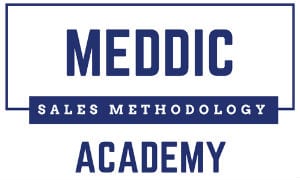In Transactional sales, Budget is key
In transactional sales with a short sales cycle and low value-added sales, it’s been prevalent to use the customer’s budget to qualify a sales opportunity. It makes sense. The budget is a crucial qualifier. The Budget is even a pillar of the framework for several older sales methodologies and frameworks such as BANT, still used to qualify inbound calls for inexpensive, transactional sales. To better compare MEDDPICC® and BANT, you may want to check some of our previous posts, here and here.
Qualifying an opportunity with Budget is not always necessary
In enterprise sales, the context is different. You have more time available, and your prospects are more sophisticated. You can quantify the pain points, define value, find metrics, convert them into economic gain, build an ROI case and sell without the need for a pre-defined budget. We go through this in many parts of the Advanced MEDDPICC® course at MEDDIC Academy and our workshops. You can even read this free blog post that describes the generic MEDDIC Sales Process, if you don’t have one.
If you show the proof of your metrics, transform them into economic gain and present them to the economic buyer, you prove that your solution is injecting money into the organization, either by increasing revenue, reducing costs or mitigating risks. Why would you need a “budget” in this case? You are not asking for money; instead, you show them how to MAKE money. If you call high enough, that is usually the Economic Buyer level. They can easily find a way to “fund” the investment. If you are selling SaaS they can sign the contract with no significant funding needed.
But, does it hurt to ask for the budget?
Yes, it does.
Here are three reasons why it is actually a bad idea:
1 – Anchoring Bias
What is anchoring bias? It’s a psychological effect that suggests that we are biased towards the first number we see or hear.
For instance, if we shop for a used car and decide to check its Blue Book value, our brain gets anchored to that initial number. Vehicles with higher prices appear expensive to us, even if they are not comparable and those under that first price tag appear like a deal that we may rush to buy.
Marketers use it everyday for price tags. $9.99 anchors the price to $9, while $10.00 obviously anchors it to $10.
An even more striking and disturbing study shows that the anchor influences even juries and judges. In one study, criminal judges were given a hypothetical criminal case, including what the prosecutor in the case demanded as a prison sentence. The prosecutor recommended 2 months for the first group of judges; for the second group, it was 34 months. Huge gap, right? On average, the first group of judges who had been given the lower anchor gave 18.78 months, while the group given the higher anchor had an average sentence of 28.7 months. These results show how sentencing demands might change a judge’s perception of a criminal case and could seriously skew their judgment. Even people who are seen as experts in their fields aren’t immune to anchoring bias.
Asking about a customer’s budget is asking for an anchor. It’s a risky question. What if the anchor is way off your price? Once the budget is “pronounced,” it plays the role of the anchor, and any number above is considered too expensive. You will be creating a problem that didn’t exist before asking that question.
2 -A Budget is a cap
In English (just like in other languages), the word “budget” implies a cap. It represents a frame, a box. We often use the phrase “within their budget.” That means we should not go beyond that number. By bringing that number up, you are creating an unnecessary limit to the size of your opportunity. The value of your solution should determine the size of the deal and the scope, not an arbitrary number in the customer’s books set the previous year.
3- Focus is on price not value
When you discuss the budget, you are having a conversation about the price and the cost of your solution. That price or cost is always too much. Buyers want to reduce that cost, ask for discounts, try to save money. In the MEDDPICC® courses, we develop ways to focus on value instead. We learn how to quantify the economic gains due to the metrics found. If you stick to measuring and presenting the value of your solution, then the customer realizes that their budget is irrelevant. Why should they deprive themselves of gaining value just because they put a number on a spreadsheet? They will, of course, need to find how to “fund” the solution. And they usually do. That’s how an intelligent seller gets the Economic Buyer to redirect the budget from other projects to this one because they helped the buyer see the value.
What are your thoughts?
If you like it, share it!


Comments are closed.